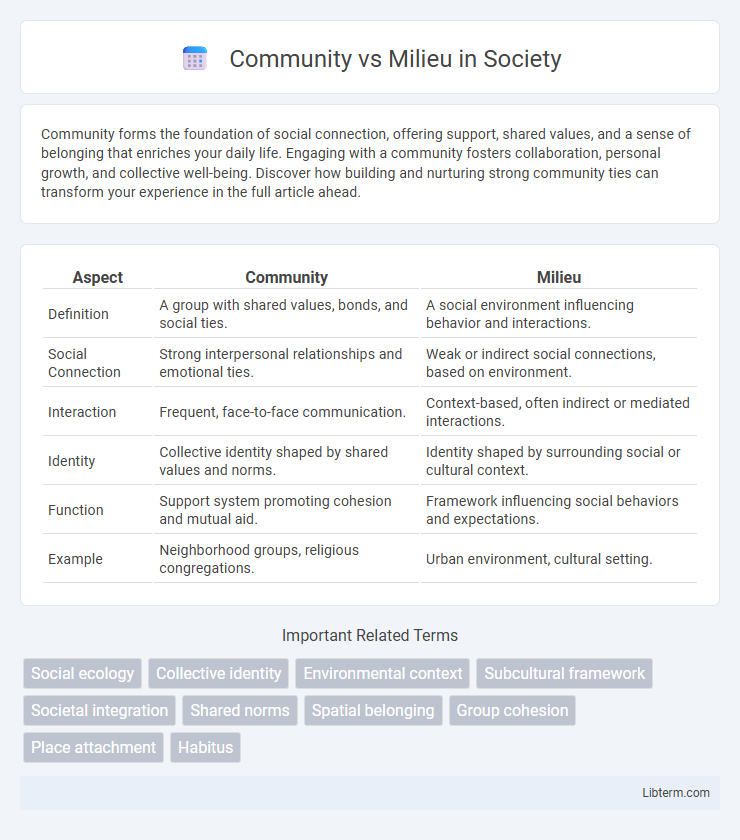Community forms the foundation of social connection, offering support, shared values, and a sense of belonging that enriches your daily life. Engaging with a community fosters collaboration, personal growth, and collective well-being. Discover how building and nurturing strong community ties can transform your experience in the full article ahead.
Table of Comparison
| Aspect | Community | Milieu |
|---|---|---|
| Definition | A group with shared values, bonds, and social ties. | A social environment influencing behavior and interactions. |
| Social Connection | Strong interpersonal relationships and emotional ties. | Weak or indirect social connections, based on environment. |
| Interaction | Frequent, face-to-face communication. | Context-based, often indirect or mediated interactions. |
| Identity | Collective identity shaped by shared values and norms. | Identity shaped by surrounding social or cultural context. |
| Function | Support system promoting cohesion and mutual aid. | Framework influencing social behaviors and expectations. |
| Example | Neighborhood groups, religious congregations. | Urban environment, cultural setting. |
Understanding the Concept of Community
Understanding the concept of community involves recognizing the shared values, norms, and social ties that connect individuals within a defined group or geographic area. Communities foster a sense of belonging and mutual support, influencing identity and collective behavior. Unlike milieu, which refers to the broader social environment or context influencing individuals, community emphasizes active participation and interpersonal relationships among its members.
Defining Milieu in Social Contexts
Milieu in social contexts refers to the physical, social, and cultural environment that surrounds individuals and influences their behavior, values, and interactions. Unlike a community, which emphasizes social bonds and shared identity among members, milieu focuses on the broader contextual factors such as socioeconomic conditions, geographic location, and prevailing social norms that shape experiences. Understanding milieu involves analyzing these external conditions and their impact on individual and group dynamics within society.
Key Differences Between Community and Milieu
Community refers to a group of people connected by shared interests, values, or geographic location, emphasizing social bonds and mutual support. Milieu describes the physical or social environment influencing individuals' behaviors and attitudes, focusing on contextual and environmental factors. The key difference lies in community highlighting interpersonal relationships, while milieu stresses the ambient conditions shaping social experiences.
The Role of Shared Values in Communities
Shared values serve as the foundation for cohesion within communities, fostering trust and mutual support among members. These common beliefs and norms guide behavior, strengthen social bonds, and create a collective identity that distinguishes communities from mere milieus. Without shared values, groups may lack the depth of connection necessary for genuine interaction and cooperative action.
Environmental Influences Within a Milieu
Environmental influences within a milieu shape social interactions by creating contextual conditions that impact behavior, norms, and relationships. Unlike a community, which emphasizes shared identity and social ties, a milieu focuses on the physical, cultural, and situational factors influencing individuals within a setting. Milieu factors such as geography, urban design, and socio-economic conditions play a critical role in molding experiences and social dynamics.
Social Bonds and Interactions: Community Perspective
The community perspective emphasizes strong social bonds characterized by shared values, mutual support, and a sense of belonging among members. Interactions within communities are typically face-to-face and involve personal relationships that foster trust and cooperation. This perspective highlights the importance of social cohesion and collective identity as foundational elements shaping individuals' behaviors and communal life.
Impact of Milieu on Individual Identity
The milieu shapes individual identity by providing the social, cultural, and physical environment that influences values, behaviors, and self-perception. Unlike the community, which centers on shared relationships and collective belonging, the milieu encompasses broader external conditions such as economic status, urban or rural settings, and prevailing social norms. This ambient context subtly molds identity development by framing daily experiences and shaping cognitive and emotional responses within the individual.
Community Building: Strategies and Challenges
Community building involves creating strong social bonds and shared identities among members through collaborative activities and mutual support systems. Effective strategies include fostering inclusive participation, leveraging digital platforms for engagement, and promoting transparent communication to build trust and resilience. Challenges often arise from cultural diversity, conflicting interests, and sustaining long-term commitment within the evolving social milieu.
Milieu Shaping Societal Norms and Behaviors
Milieu plays a crucial role in shaping societal norms and behaviors by providing the environmental context where individuals interact and form shared values. This social setting influences attitudes, cultural practices, and collective behavior patterns through continuous exposure to prevailing traditions and expectations. Understanding milieu allows sociologists to analyze how external surroundings mold individual and group conduct within a community.
Choosing Between Community and Milieu Approaches
Choosing between community and milieu approaches depends on the desired focus of social interactions and environmental influence. The community approach emphasizes shared values, social bonds, and collective identity, fostering inclusive participation and mutual support. In contrast, the milieu approach prioritizes physical and social environments as dynamic settings that shape behavior and experiences through structured settings and designed interactions.
Community Infographic

 libterm.com
libterm.com